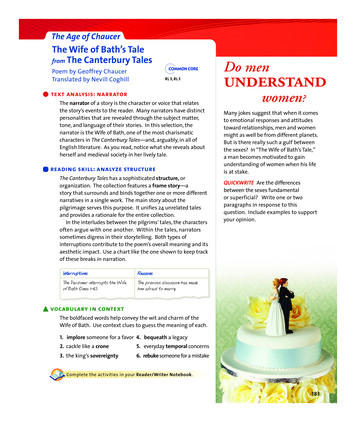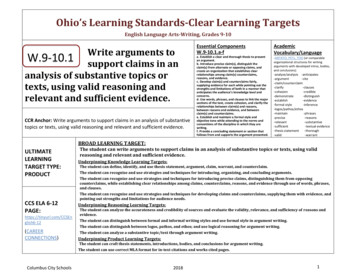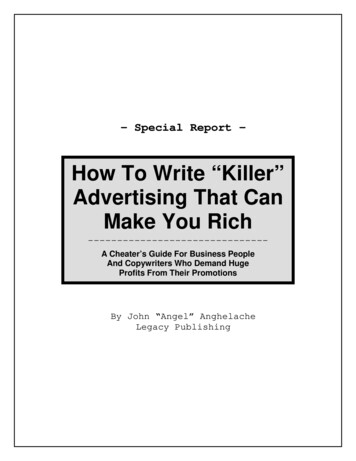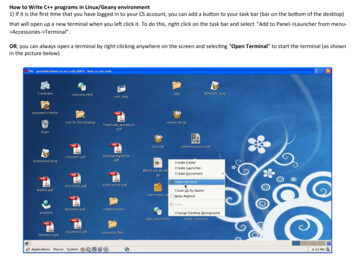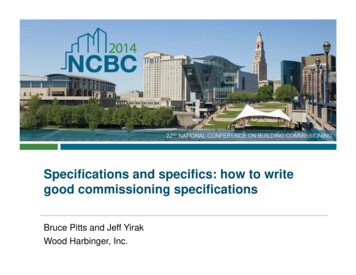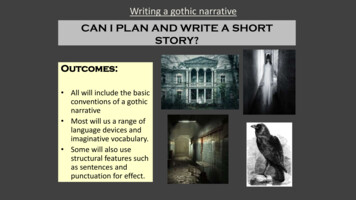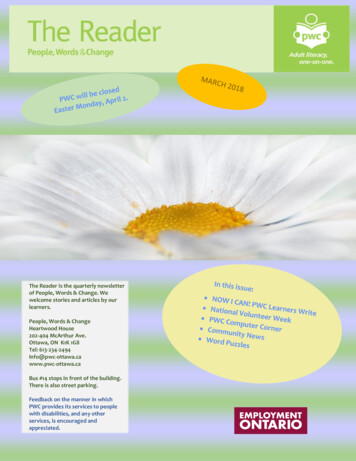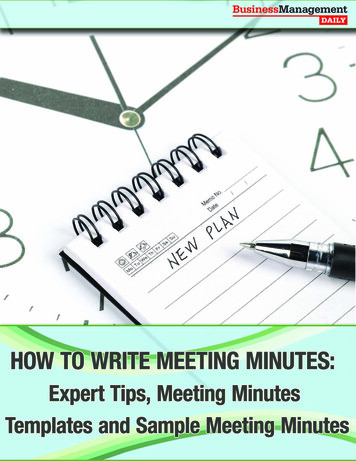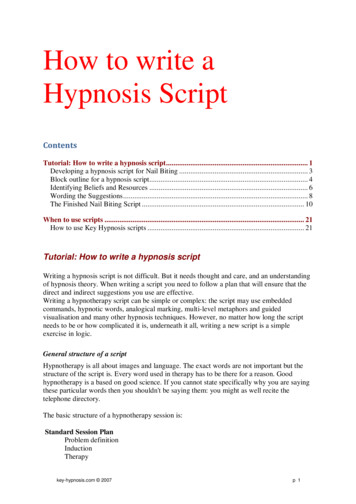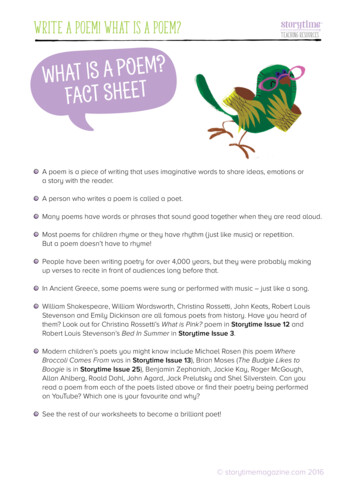
Transcription
Write a Poem! What is a poem?StorytimeTMTeaching Resources?meoPasitaWhFact SheetA poem is a piece of writing that uses imaginative words to share ideas, emotions ora story with the reader.A person who writes a poem is called a poet.M any poems have words or phrases that sound good together when they are read aloud.M ost poems for children rhyme or they have rhythm ( just like music) or repetition.But a poem doesn’t have to rhyme!P eople have been writing poetry for over 4,000 years, but they were probably makingup verses to recite in front of audiences long before that.I n Ancient Greece, some poems were sung or performed with music – just like a song.W illiam Shakespeare, William Wordsworth, Christina Rossetti, John Keats, Robert LouisStevenson and Emily Dickinson are all famous poets from history. Have you heard ofthem? Look out for Christina Rossetti’s What is Pink? poem in Storytime Issue 12 andRobert Louis Stevenson’s Bed In Summer in Storytime Issue 3.M odern children’s poets you might know include Michael Rosen (his poem WhereBroccoli Comes From was in Storytime Issue 13), Brian Moses (The Budgie Likes toBoogie is in Storytime Issue 25), Benjamin Zephaniah, Jackie Kay, Roger McGough,Allan Ahlberg, Roald Dahl, John Agard, Jack Prelutsky and Shel Silverstein. Can youread a poem from each of the poets listed above or find their poetry being performedon YouTube? Which one is your favourite and why?S ee the rest of our worksheets to become a brilliant poet! storytimemagazine.com 2016
Write a Poem! different types of poems 1StorytimeTMTeaching ResourcessepyTtnereiffDof PoemsThere are many different types of poetry. Here are some you might know.N arrative Poems tell a story. You could say that Julia Donaldson’s books, suchas The Gruffalo, are narrative poems. In Storytime Issue 1, we featured The Owl and thePussy-cat by Edward Lear, which is a narrative poem.I n Shape Poems (or Concrete Poems) the words are arranged to look like thething you’re writing about. You could write a poem about a snake in a long wiggly line ora poem about rain inside a raindrop shape. For example:RaindropRacing downthe windowpaneRaindrop can’t stopIt’s in the fast lane - whee!N onsense Poems feature made-up words, characters or places, and are funny.In Storytime Issue 4, we featured the nonsense poem On the Ning Nang Nong bySpike Milligan. Other well-known nonsense poets are Lewis Carroll and Edward Lear. storytimemagazine.com 2016
Write a Poem! Different types of poems 2StorytimeTMTeaching Resources In Acrostic Poems when you look at the first letters of each line of the poem, theyspell out a word vertically. This word links to the subject of the poem. It doesn’t have tobe the first letter that stands out – it could be the last letter of each line, or a letter in themiddle. Also, acrostic poems don’t have to rhyme. Here’s an example:Creamy and sweetA big birthday treatKids love to tuck inEat it with a grin!F ound Poems use words you’ve found somewhere. Turn to random pages in adictionary and choose words, take the first sentence from your favourite book, or ripout random headlines from a magazine or newspaper, then use the words you’ve foundto make a poem. It’s a bit like a collage with words! Haikus are Japanese poems. They don’t have to rhyme, but some do. Haikus alwayshave three lines. Line 1 has 5 syllables; line 2 has 7 syllables; and line 3 has 5 syllables:In school I can learnto climb and scale and conquermountains of knowledgeL imericks are short, funny poems with five lines. They always start with the words“There was a ” and end in a silly way. Lines 1, 2 and 5 rhyme with each other, and lines3 and 4 rhyme too. Edward Lear’s limerick There Was an Old Man with a Beard was inStorytime Issue 12:There was an old man with a beard,Who said, “It is just as I feared,Two owls and a hen,A lark and a wrenWORDWISE!Syllables are the sounds that make upwords. ‘Cat’ has one syllable, ‘cattle’ hastwo syllables (cat-tle) and ‘catalogue’has three syllables (cat-a-logue). storytimemagazine.com 2016
Write a Poem! POETRY techniques 1PoetryTechniquesStorytimeTMTeaching ResourcesThere are many clevertricks you can use to helpyou write great poems.RhymingTo make your poem rhyme, the words at end of the lines should sound the same orvery similar, e.g. cow and now. Not all poems rhyme, but it’s a fun way to get startedwith poetry. When two lines of poetry rhyme with each other, it’s called a rhymingcouplet. Here’s an example:Twinkle, twinkle little starHow I wonder what you areNotice how these two lines have the same amount of syllables? The rhymewouldn’t work as well if the first line was a lot shorter.)AlliterationThis means using lots of words that start with the same letter or sound. Alliterationsounds good when you read it out and it gives your poem rhythm. For example:On the pavement his paws go pit-patCould it be Claude the cool kitty cat?AssonanceThis is similar to alliteration, but instead of repeating the letter at the start of eachword, you repeat similar sounding vowels inside the words. This is another goodway to give your poem rhythm. For example:Today the sleigh flew off againRight through the big blue moon storytimemagazine.com 2016
Write a Poem! POETRY techniques 2StorytimeTMTeaching ResourcesRepetitionYou can repeat the same word, phrase or even line to get your idea across or to giveyour poem a more dramatic ending. This also helps to give your poem rhythm. Seehow repetition brings rhythm to Edward Lear’s The Owl and the Pussy-Cat (read it infull in Storytime Issue 1):The Owl looked up to the stars above,And sang to a small guitar,“O lovely Pussy! O Pussy, my love,What a beautiful Pussy you are,You are,You are!What a beautiful Pussy you are!”SimilesPoems are a great way to use your imagination, and similes allow you to comparetwo things using the words ‘like’ or ‘as’ (as cold as ice, as light as a feather).Twinkle, Twinkle Little Star has a good ‘like’ simile in it:Up above the world so high,Like a diamond in the skyMetaphorsMetaphors are used widely in poetry. When you use a metaphor, rather than sayingsomething is ‘like’ another thing, you say it is that thing. For instance, you might saysomeone is a ray of sunshine, or describe tree branches as a ‘wonderful stair’, like inthe poem Climbing by Amy Lowell (from Storytime Issue 21).PersonificationIn poems, you can use your imagination to bring objects or animals to life anddescribe them like you would describe a human. For example, in the nursery rhymeHey Diddle, Diddle, ‘the dish ran away with the spoon’ and, when it’s sunny, peopleoften say ‘the sun has got his hat on and he’s coming out to play’. T.S. Eliot’s OldPossum’s Book of Practical Cats with characters like Macavity the cat is a goodexample of the personification of cats. storytimemagazine.com 2016
Write a Poem! rhyming for beginners 1Rhymingfor BeginnersStorytimeTMTeaching ResourcesRhyming is fun and easy to do –especially with the help of onlinerhyming dictionaries like www.rhymezone.com. But before youuse something like this, use rhymingto test and expand upon vocabularies.Say, for example, you want to make up a rhyme about a cat. How many wordscan you think up with an –at ending to rhyme with cat? Ask everyone to come upwith as many rhyming words as they can. Write them all on the board. Here aresome simple ones to get you started:Fat Hat Mat Pat Rat SatSee if you can come up with four short lines using words that rhyme with cat.Remember: if each line has a similar amount of syllables, it sounds and reads better:There was never a catQuite as podgy and fatAs the cat that has satOn my favourite top hatTry rhyming some other simple words, such as dog, pet, snow or chair and seeour Rhyming Sheet and Poetic Pairs Sheet for some simple poetry exercises.Instead of rhyming every line in a four-line poem, try rhyming just lines 2 and 4:The puss from next doorIs podgy and fat,I know as it sat onMy favourite top hat!Or rhyme lines 1 and 2 and come up with different rhymes for lines 3 and 4:There was never a catQuite as fluffy and fatAs the cat on my lap,Which is taking a nap! storytimemagazine.com 2016
Write a Poem! rhyming for beginners 2StorytimeTMTeaching ResourcesPlay Pass the Poem. Divide your class into groups of four and give each groupone easy word to rhyme. Ask the children in each group to work together to comeup with as many rhyming words as they can, then ask each child to write one line ofa four-line rhyme and see how the finished poem turns out. Get everyone to performtheir poems when they’ve finished. Download our Pass the Poem Sheet to help youcreate your masterpieces.When coming up with your own rhymes, think about which rhyming words makethe funniest or best rhyme – or choose words that inspire you and give you ideas.These make a good starting point.Now test everyone’s new poetry skills on our Finish The Poem Sheet, have ago at some shape poems on our Shape Poem Sheets, create a found poem usingour Found Poem Sheet and try out an acrostic on our Acrostic Poem Sheet.Read the poems we’ve featured in Storytime magazine for more poetryinspiration. See what types of poems and rhymes you can spot! Also checkout these great Poetry Resources: www.brianmoses.co.uk for poems by our poetry competition judge, Brian Moses,and poems from school children. www.youtube.com/user/artificedesign/videos – Michael Rosen’s YouTubechannel. Also Michael’s new book What Is Poetry (Walker Books), out October2016, gives tips on how to write poems. www.lovereading4kids.co.uk/genre/poe/Poetry-.html – poetry bookrecommendations for under 7s from LoveReading4Kids. /main/tips-on-writing.pdf –poetry writing tips from Booktrust. childrenspoetryarchive.org – inspiring poems for kids. storytimemagazine.com 2016
Write a Poem! Rhyming SheetNameStorytimeTMTeaching ResourcesClassHow many rhymes can you find for these words? Write them down in each box.CARFEETFLY storytimemagazine.com 2016BLUE
Write a Poem! Poetic Pairs SheetNameStorytimeTMTeaching ResourcesClassCan you pair up the rhyming words? Draw a line between them.BewareFruit batBogRhymePeaSeasideHigh tideCanoeDoormatPigPeruFrogBigBeeTimeBrown bear storytimemagazine.com 2016
Write a Poem! Pass the Poem SheetNameStorytimeTMTeaching ResourcesClassPass the poem around so that each person can write his or her own line!Line 1Line 2Line 4 storytimemagazine.com 2016Line 3
Write a Poem! Finish the Poem SheetNameStorytimeTMTeaching ResourcesClassCan you give each of these poems a missing word or line that rhymes?The words you need to rhyme with are in bold.Frankie the frog,Lived in a bog,Sat on a log,Barked like aFind a penny,Pick it up,Spend it on aIn this boxThere is a foxAnd he is wearingIf you ever meet a monster,Here’s what you should do:Shake his hand and tell himLet’s play outside,Let’s go for a ride,Let’s climb, let’s shout,Let’sYou might think that on my back,I’m carrying a school rucksack,But there’s a secret tucked in there, storytimemagazine.com 2016
Write a Poem! Shape Poem Sheet 1StorytimeTMTeaching ResourcesNameClassPick a shape and write apoem about it insidethe shape! storytimemagazine.com 2016
Write a Poem! Shape Poem Sheet 2NameStorytimeTMTeaching ResourcesClassPick a shape and writea poem about it insidethe shape! storytimemagazine.com 2016
Write a Poem! Shape Poem Sheet 3StorytimeTMTeaching ResourcesNameClassPick a shape and write a poem about it inside the shape! storytimemagazine.com 2016
Write a Poem! Acrostic Poem SheetNameStorytimeTMTeaching ResourcesClassWrite an acrostic poem about the word below. It doesn’t have to rhyme!HOLIDAYTIP!Before you start, write downall the things you can thinkof when you see this word.When you’ve finished, write anacrostic poem about yourbest friend or favouriteanimal too! storytimemagazine.com 2016
Write a Poem! Found Poem SheetNameStorytimeTMTeaching ResourcesClassMake up a poem using words cut out of newspapers and magazines.Stick them in the Found Words box, then write your poem in the large box.MY Poemfound words storytimemagazine.com 2016
Write a Poem! My PoemNameStorytimeTMTeaching ResourcesClass storytimemagazine.com 2016
Write a Poem! My Poem PictureNameStorytimeTMTeaching ResourcesClassDraw a character or scene from your poem here! storytimemagazine.com 2016
out random headlines from a magazine or newspaper, then use the words you’ve found to make a poem. It’s a bit like a collage with words! haiKus are Japanese poems. They don’t have to rhyme, but some do. Haikus always have three lines. Line 1 has 5 syllables; line 2 has 7 syllables; and line 3 has 5 syllables: In school I can learn to climb and scale and conquer mountains of knowledge .
